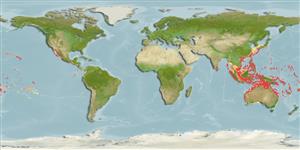Common names from other countries
>
Tetraodontiformes (Puffers and filefishes) >
Tetraodontidae (Puffers) > Canthigasterinae
Etymology: Canthigaster: Greek, kanthos = the outer or inner corner of the eye, where the lids meet, 1646 + Greek, gaster = stomach (Ref. 45335); axiologus: Species epithet 'axiologus' from the Greek words αξίος and λόγος, the latter Latinised to logus; it isnoun in apposition (CofF)..
More on author: Whitley.
Environment: milieu / climate zone / depth range / distribution range
Ecologia
marino associati a barriera corallina; distribuzione batimetrica 10 - 80 m (Ref. 90102). Tropical
Pacific: Japan to Australia, east to the Marshall Islands and Tonga; with records from Western Australia, from Exmouth Gulf northwards.
Size / Peso / Age
Maturity: Lm ? range ? - ? cm
Max length : 10.1 cm SL maschio/sesso non determinato; (Ref. 83660)
Short description
Chiavi di identificazione | Morfologia | Morfometria
Raggi dorsali molli (totale) : 9 - 11; Raggi anali molli: 9 - 10. This species is distinguished by the following characters: D 9-11 (usually 10, rarely 11); A 9-10 (usually 9); pectoral rays 15-18 (modally 16 in the North Pacific and 17 in the South Pacific); gill rakers 7-9; body depth between origins of dorsal and anal fins 3.0-3.3 in SL; head length (HL) 2.3-2.5 in SL; interorbital width 3.75-4.4 in HL; gill opening 4.8-5.55 in HL; origin of anal fin below or posterior to rear base of dorsal fin, the preanal length 1.25-1.35 in SL; longest dorsal ray 2.4-2.9 in HL; preserved colour pale grey to pale tan with 3 saddle-like, dark brown bars on body, similar to C. coronata, the edges of bars with close-set, small, pale-edged dark spots or short lines, irregularly alternating with unpigmented pale spots or lines; ventral part of body with or without small pale spots or pale-edged dark spots; across posterior interorbital and anterior occiput is a broad dark brown band; below base of pectoral fin is a dark brown spot; from chin to below gill opening, a narrow curved pale band edged in small dark spots; around eye is a pale area with radiating dark brown lines (except adjacent interorbital band); on head and abdomen is a midventral dark brown line varying from faint to conspicuous; lips pale, usually rimmed by a dusky band; fins pale grey, the upper and lower edges of caudal fin with or without a broad dark marginal band (Ref. 83660).
Occurs in sheltered habitat, often on open sand and rubble bottom near reefs; but appears to be far less common than C. coronata (Ref. 83660). Solitary (Ref. 90102).
Life cycle and mating behavior
Maturities | Riproduzione | Spawnings | Egg(s) | Fecundities | Larve
Randall, J.E., J.T. Williams and L.A. Rocha, 2008. The Indo-Pacific tetraodontid fish Canthigaster coronata, a complex of three species. Smithiana, Publ. Aquatic Biodiv. Bull. 9:3-13. (Ref. 83660)
IUCN Red List Status (Ref. 130435)
CITES (Ref. 128078)
Not Evaluated
Threat to humans
Harmless
Human uses
Strumenti
Special reports
Download XML
Fonti Internet
Estimates based on models
Preferred temperature (Ref.
115969): 24.1 - 29, mean 27.8 (based on 566 cells).
Phylogenetic diversity index (Ref.
82804): PD
50 = 0.5000 [Uniqueness, from 0.5 = low to 2.0 = high].
Bayesian length-weight: a=0.03631 (0.01554 - 0.08482), b=2.88 (2.69 - 3.07), in cm Total Length, based on LWR estimates for this Genus-body shape (Ref.
93245).
Trophic level (Ref.
69278): 3.1 ±0.3 se; based on size and trophs of closest relatives
Resilienza (Ref.
120179): Alto, tempo minimo di raddoppiamento della popolazione meno di 15 mesi (Preliminary K or Fecundity.).
Fishing Vulnerability (Ref.
59153): Low vulnerability (10 of 100).
